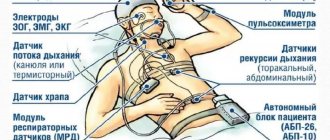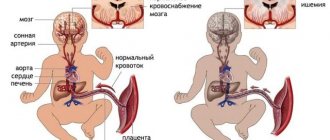Causes
Among the causes of stuttering in children, predisposing and provoking factors are distinguished. Predisposing factors are disorders, most often of an organic nature, that a child has from birth. If provocateurs join them, then a child of preschool age or primary school age will develop a pathology.
Predisposing factors:
- heredity - the presence of speech disorders in close relatives, which may indicate weakness of the articulatory apparatus, muscles and ligaments, underdevelopment of the respiratory system, congenital anomaly;
- oxygen starvation in the prenatal period and during childbirth, caused by pathology on the part of the mother (anemia, diet, threat, polyhydramnios, oligohydramnios), placenta and umbilical cord (immature placenta, premature detachment, umbilical cord entanglement);
- prematurity, in which almost all systems are immature;
- birth trauma, especially if it is not diagnosed and the baby has not received treatment;
- Features of the nervous system - hyperexcitability.
The provoking factors are as follows:
- emotional shock - severe fright, fear, anger, first visit to kindergarten;
- chronic stress due to conflicts with peers, in children's groups, ridicule, lack of friends;
- unfavorable psychological background in the family, physical punishment, constant scandals, lack of attention from parents;
- overprotection, lack of personal space, inability to express one’s opinion due to adult pressure;
- excessive demands on the child from parents, educators, teachers;
- excessive passion for computer games;
- the presence of another person around the child who stutters;
- traumatic brain injury, even of a mild degree;
- previous meningitis, encephalitis, encephalopathy.
How to distinguish a neurosis-like form of stuttering from a neurotic one
Science distinguishes 2 types: neurotic and neurosis-like forms of stuttering. A distinctive feature of the neurotic form is its connection with a psychogenic factor: fear or severe stress. It usually appears suddenly, at the age of 2 years, but can occur later. Stuttering appears or intensifies during emotional stress. The child is timid, touchy, whiny, anxious.
With age, he becomes more and more aware of his problem, begins to withdraw, avoid groups, public speaking, and then completely limits communication. If measures are not taken in time and a correction program is not started, the patient will not be able to lead a normal life: he will remain withdrawn and lonely.
Sometimes a child may have characteristics of neurosis-like stuttering along with neurotic stuttering, that is, the pathology is mixed. The task of the speech therapist becomes more complicated: it is necessary to work both with the consequences of organic damage and with psychogenic factors. Of course, treatment is carried out jointly with a psychologist, psychiatrist and neurologist.
Main signs of stuttering
Physically, children with stuttering are no different from their peers. Speech in a calm environment can be almost normal. And in moments of strong excitement, fear, rage, anxiety, the voice falters, stops, and letters, syllables, and words are repeated. The baby stretches out sounds and syllables.
Speech is generally irregular and uneven. In severe cases, the child cannot be understood.
The more the baby tries to say something, the more worried he is and the more pronounced the speech disorder is. Sometimes the pathology is accompanied by tightness in the chest, a feeling of spasm in the throat, and respiratory arrest. This condition can be described as convulsive: the tongue seems to stick to the hard palate, the lips close.
If the cause of stuttering is organic damage to the nervous system, then speech difficulties will be permanent.
For children, this condition is a huge stress. Because of fear, they try not to use words that are difficult to pronounce. Speech becomes clogged with parasites “uh”, “well”, “here”, “there”, “this”, “yes”, “so”. They communicate less and withdraw into themselves. In adolescence, this leads to complexes and serious psychological problems.
The problem is aggravated by nervous tics, enuresis, aggressiveness, tearfulness, and fear of the dark. Over time, psychosomatic diseases of the gastrointestinal tract, heart and blood vessels and other systems may appear.
Therefore, it is very important to contact doctors in time and start treatment.
Types of stuttering
There are several types of stuttering:
Depending on the mechanism of occurrence, pathology can be respiratory, vocal and articulatory-phonetic.
- With the respiratory or breathing type of speech delay, the pathology is associated with a lack of air. Because of this, the baby cannot finish a phrase or word while exhaling. During a conversation, his face becomes tense or distorted;
- Vocal stuttering is caused by involuntary closure of the vocal cords. Occurs most often with vowel sounds;
- The articulatory-phonetic form is characterized by spasm of the facial muscles. Outwardly, this is expressed by opening the mouth and contracting the lips.
Due to their occurrence, there are 2 forms:
- neurotic stuttering (logoneurosis) - associated with acute or chronic stress in children 2–6 years old, with no organic damage to the nervous system;
- a neurosis-like form occurs in children aged 2–3 years as a result of damage to the speech center of the brain due to injury or illness.
As you can see, stuttering most often begins in preschoolers. This is the most vulnerable age.
According to clinical manifestations there are:
- tonic form - hesitation, prolongation of sounds, pauses;
- clonic form - repetition;
- mixed form.
How to recognize the early stages of stuttering in a child
Pay attention to the child’s manners, gestures, speech, listen carefully to his speech. Children's hesitant speech with repetition of words is the norm between the ages of 2 and 7 years; at a later age, it is worth observing the child and paying attention to the following signs of the initial stages of stuttering:
- Frequent repetition of words.
- Prolongation of sounds, syllables, words.
- Attempts to avoid communication, fear of conversation.
- Phrases from a child about not being able to say something.
- Upset look.
- Tension in the muscles of the face, neck and voice.
- Speech with sudden rises in voice volume.
If one or more signs are noticeable, then measures need to be taken, for example, changing the style of communication with the child.
Severity
When assessing the severity of the pathology, the severity of symptoms, their impact on the child’s communication with other people, and the presence of concomitant disorders are taken into account.
Highlight:
- mild degree - it is characterized by rare, unexpressed hesitations that do not interfere with talking and communicating. But even with this degree, parents need to contact a specialist in order to begin correction in a timely manner before the deviations become entrenched;
- medium - hesitations are more noticeable and make communication more difficult;
- severe - speech impairments are pronounced, they make communication almost impossible. Other symptoms also appear.
If stuttering is not eliminated, the cause of the pathology is not eliminated, then it gradually progresses, and very quickly.
Treatment of stuttering in children
Getting rid of stuttering requires patience and persistence. It is important to follow the recommendations of a speech therapist in order to develop correct speech skills and eliminate pathology. But we also don’t recommend overdoing it: if your baby is sick or doesn’t feel well, postpone classes. In this state they will be of no use.
Treatment of stuttering in children is complex, using several therapy methods. Below we will talk about them in more detail.
Working with a speech therapist
Treatment of stuttering in children by a speech therapist can be carried out in a kindergarten, in a community clinic or in specialized institutions.
At the first stage, a speech therapist or speech pathologist conducts a survey and examination, identifying the cause of stuttering. Examinations are prescribed: MRI, electroencephalography or rheoencephalography. After this, an individual correction scheme is drawn up. Parents need to follow this plan to get rid of stuttering.
Working with a speech therapist is the key to successful correction. Even if you practice at home on your own, you need to regularly see a specialist. He evaluates the dynamics and, if necessary, adjusts the lesson plan or supplements them.
Working with a psychologist
To help get rid of stuttering, a psychologist or psychotherapist conducts classes in a playful way. The purpose of such activities is relaxation, distraction, and development of emotional stability. Both individual sessions and group work are possible.
When the cause of speech impairment is conflicts in the family, stuttering can be eliminated only by improving relationships within the family. In such cases, psychotherapy is also indicated for parents. It is necessary to create a calm environment and improve relationships between all family members. It is important that the child knows and feels that he is loved and appreciated.
Drug treatment
Drug treatment of stuttering in children is aimed at normalizing the neurological state and emotional background. Prescribe sedatives and drugs to relieve muscle spasms.
Usually vitamin complexes are also included in the treatment regimen. Folk remedies are also effective: herbal decoctions, baths, inhalations. Remember that any medicine is prescribed only by a neurologist, even herbal medicines. He takes into account the results of the examination and the cause of the child’s stuttering. Self-medication is fraught with worsening of the condition.
In complex cases, when there is damage to the central nervous system, hospital treatment or the prescription of other groups of drugs may be necessary.
Hardware techniques
Physiotherapeutic methods are used. Electrosleep and electrophoresis with sedatives are effective. You need to complete the course of treatment completely. Most often, several of these courses are prescribed, with breaks.
Computer programs have also been developed to help eliminate stuttering. Check with your speech therapist to see if they are appropriate for your situation. And remember that no program can replace comprehensive measures and independent work.
Speech therapy massage
Speech therapy massage plays an important role. It relaxes those muscles that tighten when pronouncing phrases and relieves spasms of the speech apparatus, thus helping to eliminate stuttering.
A therapeutic massage of individual parts of the body is also carried out: head, neck, shoulders, chest. Various techniques are used, including acupressure. In this case, the specialist influences the speech center through reflexogenic zones.
One of the advantages is the ability to perform at home. The first sessions are conducted by a specialist, showing the movements and correct placement of hands to the parents. In the future, the mother or other relatives perform the massage themselves. This is convenient when several courses of treatment are indicated.
Breathing exercises
The technique allows you to correct shallow, incorrect breathing and normalize the tone of the muscles involved in articulation. After classes, a preschooler masters diaphragmatic breathing, normalizes speech breathing, learns to regulate the respiratory rhythm and rate of speech, and strengthens the muscles of the anterior abdominal wall.
The specialist also teaches parents this technique so that they can perform the movements at home, since regularity of exercises and continuity of the course of therapy are important.
There are various techniques, for example, you can use Strelnikova’s exercises. They help create the correct air flow needed to pronounce words and phrases. The exercise complex is performed in various body positions, at rest and during movement. Gradually the tasks become more difficult.
You also need to train your voice. Logorhythmics classes are useful. You can get rid of stuttering by reading poetry out loud or singing it. You can even sign up for choral singing. This trains your voice and breathing.
At home, you can invite your child to blow soap bubbles, blow a cotton ball off the table, or blow up regular balloons. It is useful and fun to make boats and race to “drive” or blow them from one end of the basin to the other. Try practicing with toy wind instruments: pipes, trombone, saxophone.
Prevention of stuttering
Prevention consists of a set of measures aimed at eliminating risk factors:
- Formation of a favorable psychological background in the family, refusal of excessive guardianship, demands on the part of parents towards their child, care and a friendly attitude towards him. Remember that the basis of your actions should be love, and not the desire to make your baby a prodigy;
- Elimination of stress, emotional turmoil;
- Refusal of physical punishment;
- Developing the right daily routine for the whole family, and not just for the child;
- Complete and sufficient rest;
- A balanced diet with sufficient vitamins and microelements;
- Refusal to watch detective stories, horror films, science fiction films and programs. Instead, watch good cartoons, fairy tales and programs about nature and animals;
- Regular examinations by specialists;
- Treatment of concomitant pathology.
Tips for parents: how to treat stuttering in a child
Here are some more tips for parents to make the correction successful:
- Watch your speech - don’t burr, don’t stutter on purpose. Speak correctly, pronouncing sounds smoothly, without acceleration or deceleration;
- If there is a person with a speech disorder in the child’s environment, limit their communication if possible;
- Don’t scold your child for failures, don’t focus on them. It’s better to distract him with something: a game, drawing together. Ask him to help around the house - let him know that he is valued and needed;
- Don’t focus on speech development—direct your attention and that of your baby to other areas: physical activity, writing. Perhaps your child has some talents - help him discover them;
- But successes must be celebrated, but also without exaggeration. Don't overpraise your child;
- Remember that there are no perfect people in the world. Even many of the stars we admire and envy a little have disabilities or health problems. But this did not stop them from achieving success. Therefore, believe in your child and support him in everything. This will help him a lot;
- No matter how much you want to achieve results faster, do not overload your child with exercises and activities. Monitor his well-being, his disposition to exercise.
With timely treatment of stuttering in children and effort on the part of the child and his parents, according to various authors, the prognosis is favorable in 70–80% of cases or more. We wish you that your treatment is successful too.
Stuttering: what is it?
Stuttering (logoneurosis) is a common speech disorder that manifests itself in repeated repetition of syllables or sounds, as well as entire words.
Pathology can manifest itself as prolongation of syllables, stopping of speech. The problem is the occurrence of spasms in the respiratory muscles and muscles that are involved in the production of sounds. Stuttering is accompanied by breathing problems. Despite the fact that the mechanism of stuttering has not been fully determined, the pathology can be successfully treated. Therapy methods vary. Some involve traditional methods of treatment, others - innovative ones. However, both of them are ways to permanently rid a person of stuttering.
Approximately 4% of children suffer from this speech disorder today. In the absence of timely treatment, in the future the child may have problems communicating with peers and complexes will appear. Stuttering will cause the formation of a closed character. Some adults continue to live with stuttering because they cannot dare to seek help from a specialist. However, this is an effective and only chance to get rid of the pathology.











